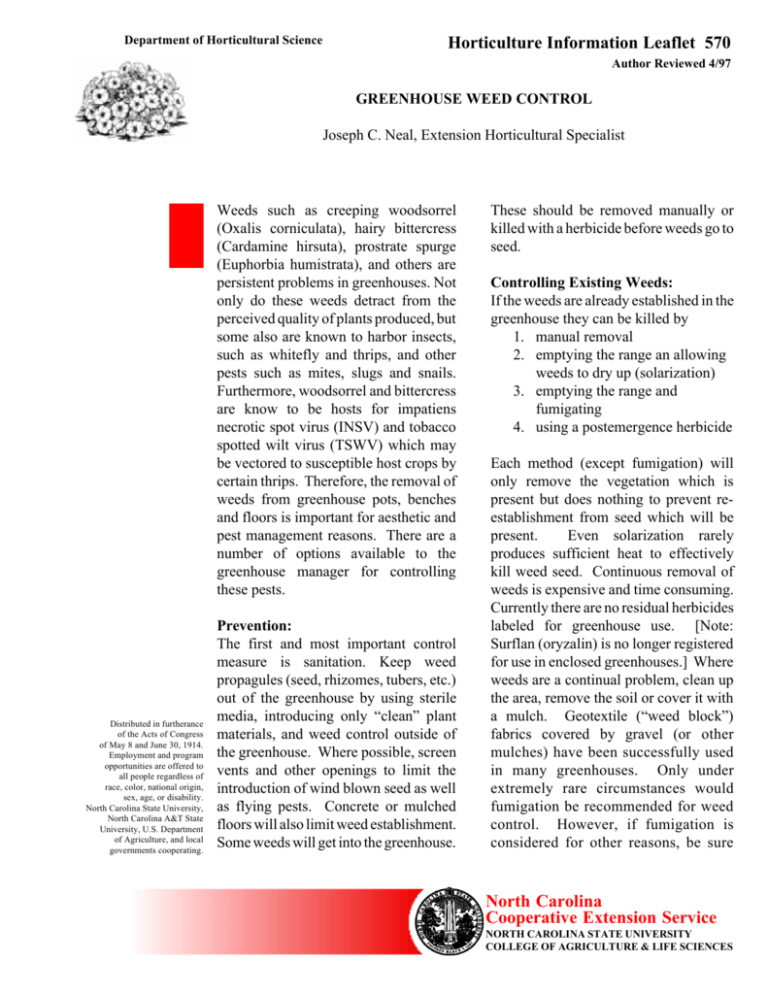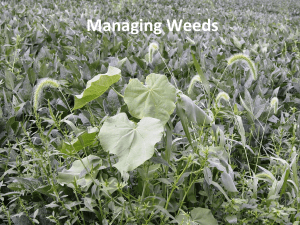Greenhouse Weed Control | NC State University
advertisement

Department of Horticultural Science Horticulture Information Leaflet 570 Author Reviewed 4/97 GREENHOUSE WEED CONTROL Joseph C. Neal, Extension Horticultural Specialist Weeds such as creeping woodsorrel (Oxalis corniculata), hairy bittercress (Cardamine hirsuta), prostrate spurge (Euphorbia humistrata), and others are persistent problems in greenhouses. Not only do these weeds detract from the perceived quality of plants produced, but some also are known to harbor insects, such as whitefly and thrips, and other pests such as mites, slugs and snails. Furthermore, woodsorrel and bittercress are know to be hosts for impatiens necrotic spot virus (INSV) and tobacco spotted wilt virus (TSWV) which may be vectored to susceptible host crops by certain thrips. Therefore, the removal of weeds from greenhouse pots, benches and floors is important for aesthetic and pest management reasons. There are a number of options available to the greenhouse manager for controlling these pests. Distributed in furtherance of the Acts of Congress of May 8 and June 30, 1914. Employment and program opportunities are offered to all people regardless of race, color, national origin, sex, age, or disability. North Carolina State University, North Carolina A&T State University, U.S. Department of Agriculture, and local governments cooperating. Prevention: The first and most important control measure is sanitation. Keep weed propagules (seed, rhizomes, tubers, etc.) out of the greenhouse by using sterile media, introducing only “clean” plant materials, and weed control outside of the greenhouse. Where possible, screen vents and other openings to limit the introduction of wind blown seed as well as flying pests. Concrete or mulched floors will also limit weed establishment. Some weeds will get into the greenhouse. These should be removed manually or killed with a herbicide before weeds go to seed. Controlling Existing Weeds: If the weeds are already established in the greenhouse they can be killed by 1. manual removal 2. emptying the range an allowing weeds to dry up (solarization) 3. emptying the range and fumigating 4. using a postemergence herbicide Each method (except fumigation) will only remove the vegetation which is present but does nothing to prevent reestablishment from seed which will be present. Even solarization rarely produces sufficient heat to effectively kill weed seed. Continuous removal of weeds is expensive and time consuming. Currently there are no residual herbicides labeled for greenhouse use. [Note: Surflan (oryzalin) is no longer registered for use in enclosed greenhouses.] Where weeds are a continual problem, clean up the area, remove the soil or cover it with a mulch. Geotextile (“weed block”) fabrics covered by gravel (or other mulches) have been successfully used in many greenhouses. Only under extremely rare circumstances would fumigation be recommended for weed control. However, if fumigation is considered for other reasons, be sure North Carolina Cooperative Extension Service NORTH CAROLINA STATE UNIVERSITY COLLEGE OF AGRICULTURE & LIFE SCIENCES the conditions are right for weed seed control as well. Before fumigating, kill above-ground portions of existing weeds and wash the interior walls, benches, and glass or plastic to remove and moisten weed seed. The soil and media should be moist but not wet and between 50 and 80 oF. The most effective, but most hazardous, fumigant is methyl bromide. If methyl bromide is to be used, it is advisable to contract out this work to a qualified fumigation specialist. In plant beds or under benches, steam sterilization can be effective. Soil / media temperature must remain at or above 180 oF for at least 30 minutes to kill most weed seed. For more detailed guidelines on the use of fumigants in greenhouses consult the North Carolina State University Plant Pathology Information Note # 140, “Soil Treatments for Plant Beds and Greenhouse – Vegetable and Ornamental Crops” by Averre et al. Scythe works better when air temperatures are high (>80 oF). Large weeds will be burned but not killed. Advantages of Scythe include lower toxicity (compared to Reward) and it may be used while a crop is in the house. Also, Scythe is the only herbicide which can be used to control weeds growing in woody plant production benches, such as rose benches. In all applications, avoid contact with desirable vegetation. The main disadvantages of Scythe are cost and it is somewhat less effective than Reward on larger weed seedlings. Additionally, the odor can persist and be offensive to some people. In contrast to Scythe and Reward, Roundup-Pro (glyphosate, Monsanto Corp.) is a systemic, postemergence herbicide which kills annual and perennial weeds and has a lower mammalian toxicity than Reward. However, when applying any pesticide in a closed environment, like a greenhouse, one should wear protective clothing, eye protection, and a respirator. Advantages of Roundup-Pro are the systemic kill of annual and perennial weeds and low mammalian toxicity. The main disadvantage is that small amounts of spray drift can severely injure greenhouse crops. Therefore, it is advisable to use Roundup only in empty greenhouses (between crops) or to shut off ventilation and circulation fans to reduce drift. If drift occurs, wait six hours then wash the benches and sides of the house; otherwise, condensation containing Roundup may drip onto plants. Chemical Control of Greenhouse Weeds: Only four herbicides are labeled for use inside greenhouses. There are very specific restrictions on the use of herbicides in greenhouses. With one exception, the products described below are only for use under benches, in walkways and around the foundation of the greenhouse. They are not for use in pots or ground beds where crop plants are growing. Read the label and carefully observe any precautions. Always wear personal protective equipment when applying pesticides in a greenhouse. Reward (diquat, Valent Corp.) is a postemergent contact-type, non-translocated weed killer. It is good for killing small annual weeds under plant benches, in walkways and around the greenhouse foundation. Large weeds will be burned but not killed. Reward is relatively toxic. Always use the recommended safety equipment when spraying Reward. Advantages of Reward include rapid kill of seedling weeds, it may be used when a crop is present in the house, relatively low cost, and small amounts of spray drift will cause only cosmetic damage to the crop but will not translocate to kill entire plants. Disadvantages of this herbicide are lack of control of perennial or well established weeds and the relatively high mammalian toxicity. Finale (glufosinate-ammonium, AgrEvo Corp.) is also a non-selective, systemic, postemergent herbicide which may be used to control weeds on greenhouse floors, under benches, and around the foundation. Air circulation fans must be turned off during the application. Avoid aerial drift by using a low pressure, large droplet type nozzle. Finale is similar to Roundup, in that it is a translocated, non-selective herbicide with no soil activity in clay soils. However, in contrast to Roundup, Finale produces symptoms more rapidly (often within 48 hours) but may not control rhizomatous perennial weeds as well as Roundup. Do not use Finale in greenhouses containing edible crops. Scythe (pelargonic acid, Mycogen Corp.) is also a postemergent, contact-type, non-translocated herbicide which controls small seedling weeds. 2 Table 1. A comparison of herbicides labeled for use inside greenhouses. Herbicide Mode of Action Time for symptoms Use with crop in house Use in soil beds Toxicological or in benches properties * REI ** Reward contact 2 to 12 hr yes no eye & skin irritant LD50: 230 mg/kg 24hr Scythe contact ½ to 2 hr yes yes, directed in roses & other woody crops severe eye irritant LD50: >5000 mg/kg 24hr Finale systemic ~2 days yes no may cause eye or mild skin irritation LD50: 3570 mg/kg 12hr Roundup-Pro systemic ~7 days no no may cause mild skin or eye irritation LD50: >5000 mg/kg 4hr *LD50: the dosage required to kill 50% of the test animals, expressed as the milligrams (thousandths of a gram) of herbicide active ingredient per kilogram (1000 grams) of body weight. The larger the LD50, the safer it is. **REI: Worker protection standard prescribed restricted-entry intervals. For this time interval following a herbicide application, workers are not to enter treated areas without wearing personal protective equipment (PPE) for activities that would bring them in contact with treated surfaces. Depending upon the herbicide, the PPE required may be as simple as shoes, socks, coveralls, and rubber gloves. Check the AGRICULTURAL USE REQUIREMENTS section of the label for required PPE. not use auxin-type herbicides, such as those labeled for broadleaf weed control in turf, near greenhouses. When spraying weeds around the greenhouse, close windows and vents to prevent spray drift from entering the greenhouse. Vents and windows may be opened almost immediately after spraying. Outside of the Greenhouse: The primary objectives of weed control outside the greenhouse is to eliminate a major source of air borne weed seed and to prevent perennial weeds such as bermudagrass or bindweed from growing under the foundation and into the greenhouse. Additionally, weed control around the greenhouse may also serve to reduce populations of flying insect pests. Many options are available for controlling these weeds. Mowing will prevent the majority of weed seed formation. However, a vegetation-free strip is recommended immediately adjacent to the foundation. Use a geotextile fabric covered with gravel or other inorganic mulch. As an alternative to the geotextile or as a supplement when weeds grow in the mulch, postemergent and soil residual herbicides may be used. Surflan (oryzalin) has been used successfully for residual weed control. Apply Surflan with a calibrated sprayer to achieve a dosage of 2 to 4 lb ai/ A. Surflan may be mixed with Reward, Finale or Roundup for post and preemergent weed control. Do No herbicide controls all weeds, so some weeds will escape control. Remove these escaped weeds by hand before they go to seed. When sanitation, mulching, postemergent herbicides, and manual weed removal are combined into a comprehensive weed management program, weed populations will be reduced. This results in less time spent removing weeds, lower costs for weed control, and more grower time available for other jobs. In addition, the control of weeds under the benches will prevent weed introduction to plants growing on the benches, and reduce other weed-related pest problems such as whitefly, mites, thrips, slugs and snails. 3






